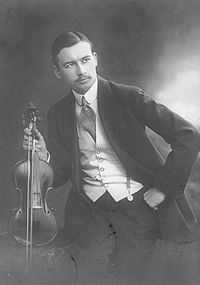Franz von Vecsey

Franz von Vecsey (Hungarian: Vecsey Ferenc, 23 March 1893 – 5 April 1935) was a Hungarian violinist and composer, who became a well-known virtuoso in Europe through the early 20th century.
He was born in Budapest[1] and began his violin studies with his father, Lajos Vecsey, and at the age of eight he entered the studio of Jenő Hubay. Two years later, aged ten, he played for Joseph Joachim in Berlin and subsequently became known as a stellar child prodigy virtuoso.
He became one of the pre-eminent violinists in Europe in the 1910s and '20s, at one point touring with Béla Bartók as his piano accompanist. Aged only 12, he became the re-dedicatee of Jean Sibelius's Violin Concerto in D minor in 1905, after the original dedicatee, Willy Burmester, refused to play the work after he was unable to appear at the premiere of the revised version and it was premiered by Karel Halíř instead. Vecsey championed the Sibelius concerto, first performing at when he was only 13,[2] although he could not adequately cope with the extraordinary technical demands of the work.[3] He was also the dedicatee of Hubay's Violin Concerto No. 3.[4] He also spent time composing, and wrote a number of virtuosic salon pieces for the violin.
His career steadily faltered after the First World War, as he grew tired of constant touring and wanted to concentrate more on conducting. By the 1930s, he was about to embark on that dream, but it suddenly curtailed when in 1935, he became seriously ill with a pulmonary embolism that grew through much of his life. He sought medical care in Rome. The operation was unsuccessful, and Vecsey succumbed to the disease at the age of 42.[1]
Selected compositions
Violin solo
- Preludio e Fuga in C minor (1914); dedicated to Jenő Hubay
Violin and piano
- La Campanella (1934); transcription based on the Rondo from Violin Concerto No. 2 by Niccolò Paganini
- Caprice in F♯ major (1913)
- Caprice fantastique (1933)
- Caprice No. 1 "Le Vent" in A minor (1916)

- Caprice No. 2 "Cascade" in F♯ major (1916)
- Caprice No. 3 "Valse macabre"
- Caprice No. 4 "Badinage"
- Caprice No. 5 "La Lune glisse à travers les nuages" (1917)
- Caprice No. 6 "Octaves dansantes"
- Caprice No. 7 "Claire de lune"
- Caprice No. 8 "Feu d'étincelles"
- Caprice No. 9 "Reflets dans l'eau"
- Caprice No. 10 "Pensée fantastique"
- Le Chagrin de Pierrot
- Chanson nostalgique (1933)
- Chanson triste (1913)
- Conte passionné in G major (1913)
- Fantaisies (1921)
- No. 1 – Devant un tombeau
- Mariä Wiegenlied (1934); transcription of Max Reger's Op. 76, No. 52
- 3 Morceaux (1912)
- No. 1 – Rêve (A minor)
- No. 2 – Humoresque (E minor)
- No. 3 – Menuetto (E major)
- Motus Barbarus
- Plainte nostalgique
- Preghiera in G♯ minor (1924)
- Préludes (1921); Nos. 3~5 also for 2 violins and piano
- No. 1 – À toi
- No. 2 – Nuit du Nord
- No. 3 – Badinage impertinant
- No. 4 – Claire de lune sur le Bosphore
- No. 5 – Pourquoi ...
- No. 6 – Nostalgie
- No. 7 – Rêverie
- No. 8 – Pensée triste
- Souvenir (1913)
- Valse lente (1933)
- Valse triste in C minor (1913)
References
- ↑ 1.0 1.1 Grove's Dictionary of Music and Musicians, 5th edition
- ↑ Madison Symphony Orchestra program notes
- ↑ Musical criticism.com
- ↑
External links
|